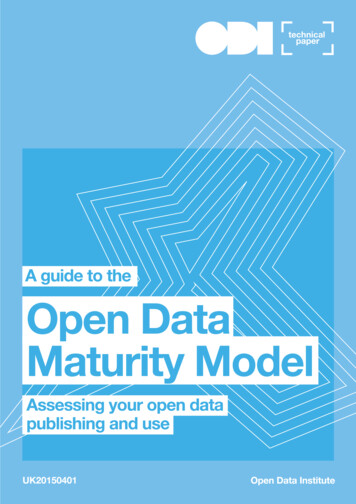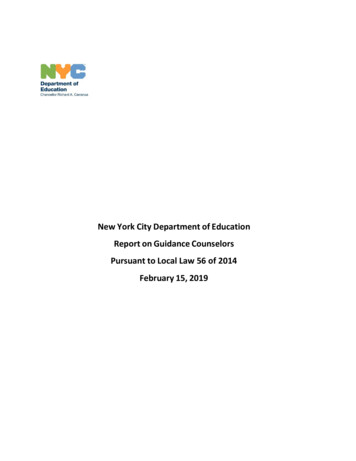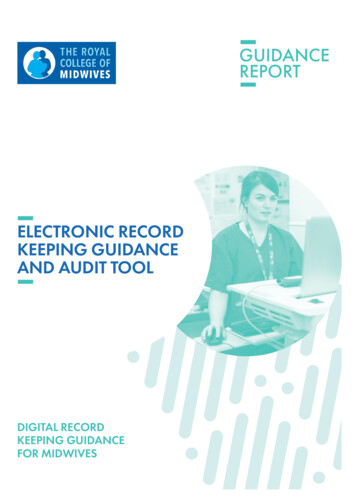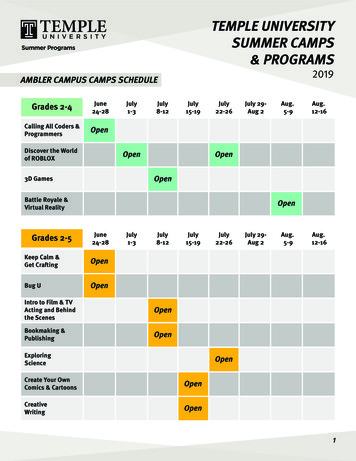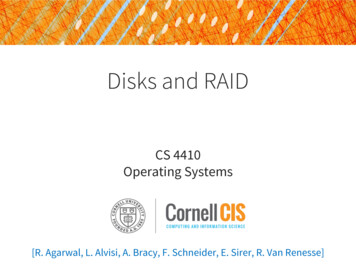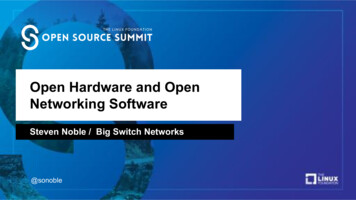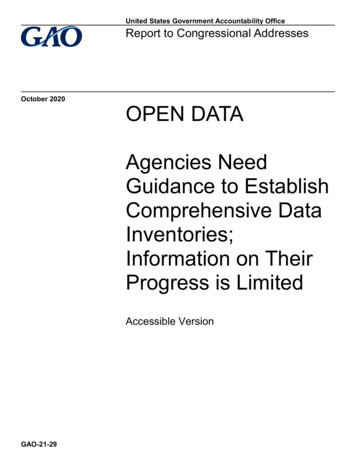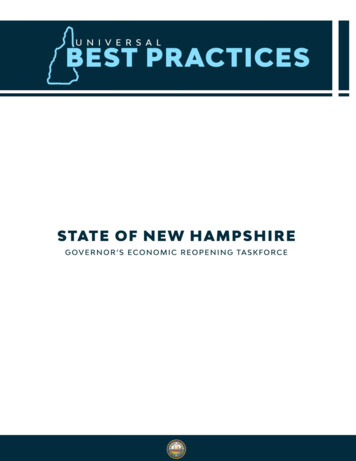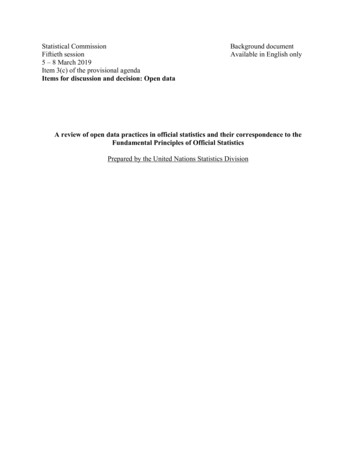
Transcription
Statistical CommissionFiftieth session5 – 8 March 2019Item 3(c) of the provisional agendaItems for discussion and decision: Open dataBackground documentAvailable in English onlyA review of open data practices in official statistics and their correspondence to theFundamental Principles of Official StatisticsPrepared by the United Nations Statistics Division
A review of open data practices in official statistics and their correspondenceto the Fundamental Principles of Official Statistics.A. IntroductionBecause of the centrality of statistics in setting policies and measuring their outcomes, national statisticaloffices (NSOs) and national statistical systems (NSSs) should be at the forefront of the data revolutionand the open data agenda. Although their specific responsibilities differ from country to country, NSOsgenerally have the authority to set statistical standards; to design and implement large-scale datacollection programs; and to ensure the quality, reliability, and availability of official statistics. NSOsgenerally also have the trust of citizens and governments to make data open without breaking privacy orconfidentiality. By collaborating with other NSOs and international statistical agencies, they contribute toand benefit from technological innovation, the development of new methodologies, and the adoption ofcommon standards. For NSOs and their partner agencies across NSSs, open data (see Box 1) is more thana dissemination strategy: embracing the principles of open data is an opportunity to engage with the largerworld of data-driven innovation, potentially leading to economic value1, cost savings, and processimprovement and to demonstrate their relevance to their own governments, the private sector, and thepublic at large.The United Nations Statistical Commission’s Friends of the Chair Group on the Implementation of theFundamental Principles of Official Statistics (FOC-FPOS) has undertaken a comparison between the 10United Nations Fundamental Principles of Official Statistics (FPOS) and the 6 Principles of the OpenData Charter (ODC). The results of this comparison can be found in the Appendix B.Set in the context of the above comparison, this background document firstly examines the practicalapplication of open data principles in official statistics, with a focus on challenges related to open datastandards; data interoperability; public engagement; and protection of data privacy. The paper thendiscusses the capabilities and activities necessary to deliver open data. The third section looks at theemerging issues that arose through the recent review of the Open Data Charter, namely: openness bydefault, data sovereignty, data governance, management and infrastructure, and data privacy, security, andconfidentiality. Finally, the paper draws all this together in its conclusion.B. Practical application of open data in official statisticsThis section will explore some of the key issues that emerge when NSOs seek to make their statistics anddatasets available as open data: open data principles; data interoperability; licensing; public engagement;and protection of data privacy. This section provides a broad introduction to these issues and points tofurther resources on the subject.Implementing open data principlesImplementing open data means operationalizing open data principles, such as the requirements of theOpen Definition or the principles of the Open Data Charter. Guidance on the implementation of the OpenDefinition is provided in OKI’s Open Data Handbook. Additional materials on the components,dimensions, and applications of open data can be found from a variety of sources, including: the OpenData Institute’s (ODI) series of Guides, the World Wide Web Foundation’s (Web Foundation) Researchsection, and materials from the Open Data Charter’s Resource Centre. All these materials, and many ult/files/analytical report n9 economic benefits of open data.pdf
are freely available for use by NSOs seeking to better understand the opportunities available for them toleverage the benefits of open data for official statistics.Box 1. Definition of Open Data.Open Knowledge International’s (OKI) Open Definition 2 provides a short, simple definition ofopen data:Open data is data that can be freely used, re-used and redistributed by anyone –subject only, at most, to the requirement to attribute and share alike.The Open Definition 2.1 states four requirements for open data:1.1 Open License or Status - The work must be in the public domain or providedunder an open license.1.2 Access - The work must be provided as a whole and at no more than areasonable one-time reproduction cost and should be downloadable via theInternet without charge.1.3 Machine Readability - The work must be provided in a form readilyprocessable by a computer and where the individual elements of the work can beeasily accessed and modified.1.4 Open Format - The work must be provided in an open format. An openformat is one which places no restrictions, monetary or otherwise, upon its useand can be fully processed with at least one free/libre/open-source software tool.The Open Data Charter follows a similar schema, with four principles that define openness: 1)Open by Default; 2) Timely and Comprehensive; 3) Accessible and Usable; 4) Comparable andInteroperable. And two that describe the purpose of open data: 5) For Improved Governance andCitizen Engagement and 6) For Inclusive Development and Innovation.Open Data Watch (ODW) has operationalized the Open Definition in its Open Data Inventory (ODIN)methodology, which assesses data coverage and openness of national statistical systems. The ODWOpenness Assessment has five elements, namely: (1) machine readability; (2) use of non-proprietaryformats; (3) availability of multiple download options; (4) availability of metadata providing sufficientcontext to understand the data; and (5) open licensing. ODW’s assessment methodology is available toNSOs or other statistical agencies for self-assessment.3 Countries wishing to improve the openness oftheir data can do so at a relatively low-cost by: providing data in machine-readable formats; makingmetadata available; and publishing open terms of use. Without machine readability, perhaps the mostimportant of the elements, users cannot easily access and modify the data, which severely restricts thescope of the data’s use. More information on this and the other elements in ODIN are dealt with in moredetail in Appendix gy.pdf
InteroperabilityData interoperability is the ability to easily extract data and to use it and integrate it with other datasetsacross different systems4. It is therefore an enabler of open data and a pre-condition for data to haveimpact on policy and decision-making process. Moreover, data interoperability is a multi-dimensionalcharacteristic of good quality data, which requires adequate institutional and governance frameworks; theadoption of standard data and metadata models, classifications and vocabularies for structuring anddescribing information; and the use of standard technological platforms, interfaces and protocols to allowusers to find, link, and integrate datasets from different sources, both manually and by automated means,into their own applications. The Collaborative on SDG Data Interoperability5 convened by the UNStatistics Division and Global Partnership for Sustainable Development Data (GPSDD) launched DataInteroperability: A practitioner’s guide to joining up data in the development sector6 at the 2018 WorldData Forum, held in Dubai, UAE in October 2018. The Guide identifies five dimensions ofinteroperability that are required for the development of data systems and processes capable of integratingdata from numerous sources, including data published in open data-friendly formats.The implementation of interoperability standards for the publication of open data by NSOs and otherorganizations also requires the adoption of common metadata schemas, vocabularies and classifications todescribe individual datasets. For example, the Data Catalogue Vocabulary (DCAT), and its manyderivatives, is recommended by the World Wide Web Consortium (W3C) — an international communityof experts who develop web-based standards — as standard for structuring metadata in an open andinteroperable way.Since the 1990s, the accelerated development of Web technologies has made the work of finding,merging, and linking data across systems much easier. Modern tools for data exchange and disseminationon the web, such as web-services based on open APIs, can be used by multiple users to run their differentanalytic applications with the most up-to-date information as soon as the data becomes available. Further,standardized interfaces and bulk downloading options can make it much easier for users to find andaccess data over the web, and to seamlessly integrate it into their own business processes. Takingadvantage of new technologies for automation of data integration (e.g., through Artificial Intelligence) isnow a priority for statistical organizations, particularly in the face of the increasing amount of data that isgenerated across society and needs to be collected, processed, analysed and openly disseminated tosupport informed decision-making at all levels.However, the implementation of technical standards and solutions to improve data interoperability in thecontext of legacy systems and architectures (which are often characterized by unknown dependencies andincomplete documentation) requires difficult, complex, and often costly organizational and behaviouralchanges. This includes the establishment of new processes and governance mechanisms, as well as theinvestment of resources to develop new skills and build capacity to implement new standards,technologies and tools.Furthermore, to fully maximize the benefits of open data, it is important that statistical organizationsprioritize data interoperability standards which are commonly used by a broad range of stakeholders.Although data interoperability standards are a deeply technical issue, their practical implementation is still4Liz Steele and Tom Orrell, 2017, The frontiers of data interoperability for sustainable development. Available loads/2017/11/JUDS Report Web teroperability‐data‐collaborative6Luis Gonzalez Morales and Tom Orrell, 2018, Data Interoperability: A practitioner’s guide to joining up data in thedevelopment sector. Available at: ces development%20sector.pdf
highly variable between countries, and should be driven by the needs of users beyond specific local andnational contexts.Public engagementAs the data ecosystem expands, NSOs are expected to take a stronger coordinating role encompassingnew data sources, producers, and users, including both public and private actors. NSOs must now engagewith an increasingly diverse set of stakeholders, including government agencies, academic institutions,non-governmental organizations (NGOs), businesses, and bilateral and multilateral institutions. To adoptthe “leave no one behind” principle of the 2030 Agenda for Sustainable Development, NSOs need tobuild a broad coalition of all segments of society and make sure all producers and users of data arecounted and benefit from the systematic implementation of open data principles across the NSS. Byembracing open data principles and practices, NSO can raise their standing as the trusted institution thatensures all users have ready access to high-quality data and statistics that meet national and internationaldemand for information, while protecting privacy and confidentiality in line with the FundamentalPrinciples of Official Statistics. In embracing open data principles and practices, there is a responsibilityon the NSO to adhere with agreed standards and best practices.NSOs should be, by their design, apolitical government organizations. Politics, however, can becomeentangled in NSO activities as official statistics are often used to justify funding decisions from donors7 orgovernments,8 including fiscal policy and other functions of state power.9 In this context, NSO leadershipoften lack or are hesitant to use their political capacity to push for an open data agenda.10 There is needfor a national consensus and high-level commitment by governments to support a long-term open datamovement, providing the necessary political backing to introduce necessary changes in national datapolicies and infrastructure. Therefore, instead of focussing only on the technical challenges of producingdata and statistics, NSOs should also invest effort into documenting successful applications thatdemonstrate the value of high-quality, trusted, and open data for policy and decision making at all levels,with a view to increase support for open data policies across the NSS.It is important that NSOs undertake a consultation with their local (prospective) user groups beforeembarking on a program to open their data. Every national and subnational context is unique and, to theextent possible, data users should be consulted on how their needs could be met. This user-centredapproach can help to build trust in the NSS as well as enable the emergence of new innovations andbusiness models that rely on open statistical data.An important first step is to secure political and institutional support for open data in official statisticswithin the government and obtain the support of other stakeholders. This effort should be coordinatedwith any existing government-wide open data initiative. The legal framework and access-to-information7Justin Sandefur and Amanda Glassman, 2014, The Political Economy of Bad Data: Evidence from African Survey& Administrative Statistics. Available at: tatistics-working.8Samantha Custer. and Tanya Sethi (Eds.), 2017, Avoiding Data Graveyards: Insights from Data Producers andUsers in Three Countries. Available at: eyards-report.html.9Florian Krätke and Bruce Byiers, 2014, Implications for the Data Revolution in Sub-Saharan Africa. Available 2014.pdf.10World Bank, 2017, World Bank support to open data 2012-2017. Available -bank-open-data-support.pdf.
policies should be reviewed and revised as necessary to support open data policies. Open data should beincorporated in countries’ National Strategies for the Development of Statistics (NSDS) – as Ghana hasdone with their 2017-2021 NSDS11 – as well as in the planning and implementation of SDG nationalreporting platforms. Countries can also carry out an Open Data Readiness Assessment (ODRA)12 as thebasis to identify a road map for implementing a national open data policy. And, just as NSOs shouldchampion open data in their own countries, their perspectives and voices are needed at internationaldiscussions around open data such as the International Open Data Conference and United Nations WorldData Forum.NSOs should also consider participating in (or establishing, where none already exists) domestic,regional, and international multi-stakeholder networks that bring official and non-official data producersand users together to coordinate, explore, and improve data systems. Here are some internationalnetworks that NSOs should consider engaging with: the Open Data for Development Network (OD4D),Open Government Partnership (OGP), Global Partnership for Sustainable Development Data (GPSDD),Global Open Data for Agriculture and Nutrition (GODAN), and Open Data Charter. Not all of thesenetworks will be appropriate for all NSOs, however, collectively they offer a way to reach out to opendata user groups and provide avenues for staying up-to-date on new open data practices and innovations.Beyond coordination efforts and building political support, NSOs can engage the public through theirwebsites and open data portals.To facilitate reporting and public engagement, the UNECE has created a practical guide on nationalreporting platforms for the SDGs.13 The development by Open Data for Development of regional hubs14that support open data as well as the inclusion of NSO representatives at the IODC and UNWDF15 arealso important developments that bring more engagement between the open data and official statisticscommunities.Data PrivacyNational statistical systems are the repositories of two kinds of data: microdata — which are the unitrecords of censuses, surveys, and administrative datasets — and aggregate statistics compiled frommicrodata. Raw microdata contains individually identifiable information about people, businesses, orother entities. Therefore, before microdata can be made disseminated, they must be anonymized oraggregated into data files suitable for public or licensed use using tools such as SDCMicro16. Access tothe underlying microdata must be strictly controlled using various accountability mechanisms, such asrequiring users to register, to agree to strict terms of use, and describe exactly who will use the data, andhow they will use it. Some countries only allow microdata downloads after a rigorous case-by-casereview process. Accordingly, countries must find a balance between protecting respondent informationfrom potentially malicious use and allowing hana NSDS html13The guide is available fromhttps://statswiki.unece.org/display/SFSDG/Task Force on National Reporting Platforms?preview /128451803/170164503/NRP practical%20guide Note%20from%20UNCES%20SG%20SDG%20TF%20NRP.pdf . See also thebackground document entitled “Principles of SDG indicator reporting and dissemination platforms and guidelinesfor their application”, which is being submitted to the consideration of the Statistical Commission at its lbox12
The first step for anonymizing microdata is to remove personally identifiable information, such as names,addresses, social security, geo-references, and id numbers. This is done by removing the informationentirely and/or by adding statistical noise to the data so that the information can’t be directly linked to anindividual. Addresses or geospatial coordinates should be aggregated to prevent the re-identification ofindividual respondent while still providing sufficiently granular location information that is useful foranalysis.Though anonymization of datasets is a good practice, it is not always enough to keep a dataset private,especially in the case of datasets with many variables. High-dimensional datasets can be joined with otherdatasets to reidentify participants, as was done by two computer scientists for a Data for DevelopmentChallenge.17 Extra care should be taken to anonymize and protect these high-dimensional datasets. Theremay remain, however, some risk of disclosure of information regardless of the steps taken. Because allmethods of anonymization degrade the information contained in a dataset (and not publishing removes allvalue), a decision to anonymize data or limit their release must also consider the likelihood of disclosure,the harm done in case of disclosure, and the public’s right to information.Open data risk assessments, like the one that the city of Seattle implemented in 2018,18 can be used toanalyse the risks associated with different datasets and create appropriate policies to protect those datadepending on the value of the data and the potential threat to their confidentiality. Open data risksassessments also help define accountability in case of breach of confidentiality. In addition, tools arebeing developed that will help address this challenge.C. Activities and capabilities that support Open Data across the official statistical systemThis section provides the basic elements that promote open data within the system of official statistics.Emphasis is placed on key activities and capabilities necessary to deliver open data; as well as activitiesto support the use of statistics among users.ActivitiesOpen data aligns with the United Nations Fundamental Principles of Official Statistics. Implementing theopen data approach for official statistics enhances the availability of statistical information to users whomonitor the economic, demographic, social and environmental situation of a country (Principle 1 of theFundamental Principles of Official Statistics). In addition, open data activities support important officialstatistical norms and standards, as well as ensure confidentiality of published data. This is underpinned bya transparent legal basis (Principles 6 and 7 of the Fundamental Principles of Public Statistics).Although open data is mainly associated with the dissemination stage, the process of making data openhas an impact on many phases of the statistical production process, from users’ needs specification andsurvey designing to survey evaluation. Employing open data standards in the statistical practice can boostefficiency in the analysis of data sets. The use of open Application Programming Interfaces (APIs) canalso be beneficial in the data collection and processing phases, especially in relation to the use ofadministrative data essment‐for‐City‐of‐Seattle.pdf
Open data provides supplementary path for the official statistical system to engage with users, but itrequires close collaboration with partners and customers. Current experience has shown that open dataprovides new access opportunities to the public; and this has resulted in measurable improvements in theform of economic growth, employment and competitiveness19. An open data approach can enhance thedissemination and use of official statistics.The creation of Open Data Strategy 20 can be a useful tool to inform the society and manage statisticsdissemination. For a better understanding and interpretation of statistical data, distributed also inmachine-readable formats, it is necessary to develop an appropriate metadata policy. Users of the datadissemination portals and other data dissemination channels (such as online APIs) should be able to easilysearch and select the data they need and all the appropriate descriptive information (metadata), includingcomplete information on the methodology used to generate the data (Principle 3 of FundamentalPrinciples of Official Statistics). A clear message and readability of adopted rules help to minimise thethreats related to methodological misunderstandings or confusion because of disinformation. Moreover, itcan be an element that reduces doubts about maintaining the confidentiality of statistical informationwithin open data process.In the case of official statistics, the implementation of open data often means only changes in the formatof data that are already published. Considerations such as data management, version control,anonymization, data quality, and approval mechanisms that normally bear on open data are generallyaddressed via the national statistical system. Thus, the relatively minor task of publishing anddisseminating official statistics in an open format (in addition to whatever form they are alreadydisseminated) could produce early benefits with only modest efforts and cost, and may be possible toachieve within the NSO’s existing mandate and authorityCapabilitiesThe necessity of using professional standards, including for the communication and delivery of statisticaldata to users, is embodied in the Principle 1 of the Fundamental Principles of Official Statistics. To fulfilthis requirement the development of a special set of technical capabilities is vital. Additionally, theprofessional implementation of the above-mentioned activities requires NSOs take an innovativeapproach in the scope of organization and personal capabilities.The open data process should be perceived as the continuing development of skills and competencies. Inthis context, NSOs should manage three groups of capabilities which are key for a successful dataopening process, namely: IT, organizational capabilities, and personal capabilities. The most essentialcapabilities necessary to implement open data in official statistics have already been used and developedin the statistics production for years, including capabilities in research programming, quality control, dataand metadata management, as well data analytics and s/default/files/analytical report n9 economic benefits of open data.pdf20European Data Portal
In the context of open data dissemination, while considering the view of users’ needs, greater emphasismust be laid on two main groups of capabilities which are needed to embed an open data approach intothe broader statistical practice. They are as follow:1. Open data communication includes skills related to the various channels of communicationbetween the statistics producers and data users. It should include clear way of data presentation,storytelling with data, high quality data journalism and data visualizations which encourage usersto engage and interact with the data. Additionally, a data distribution strategy should describe theway statistical data and metadata is disseminated according to the designed open data process.2. Data delivery skills concern knowledge about the creation of effective data delivery mechanismsusing appropriate IT tools and technical standards, such as open data formats and welldocumented open API specifications. For future activities, the recognition of the linked open data(LOD)21 concept is a key element.The implementation of open data is an opportunity to widen the use of data assets produced nationalstatistical systems. Data dissemination channels, IT skills development and clear communication, whichare adjusted to users’ needs, are factors contributing to increasing the trust in a statistical institution andare discussed in international fora22. Developing capabilities related to the newest technological solutionsis therefore inevitable to promote integrated, effective and user-friendly products within the officialstatistical system.D. Emerging issues in the Open Data CharterAs highlighted above, the United Nations Statistical Commission’s Friends of the Chair Group on theFundamental Principles of Official Statistics (FOC-FPOS) has undertaken a comparison of the 10 UnitedNations Fundamental Principles of Official Statistics (FPOS) and the 6 Principles of Open Data Charter(ODC). It should be noted that this is not the first time, nor the last, that the two frameworks will beconsidered in a unified manner. For example, many of the underlying threads / themes throughout theInternational Open Data Conference 2018 (IODC18) in Buenos Aires had strong linkages to the FPOSand have been echoed in ‘FPOS centred’ meetings.There has been recent consultation on refreshing the International Open Data Charter (ODC) Principles,with a relaunch scheduled for early 2019. Throughout this process several issues have emerged which arerelevant for National Statistical Offices (NSO) as they investigate the implementation of principles fromthe Open Data Charter.Open by defaultThere has been strong debate throughout the consultation of the Open Data Charter Principles about theprinciple “open by default”. Overall it is still held as a fundamental principle needed to guide behaviourtowards proactive open government and the maximisation of potential value from data; however, it is feltthat the expression “open by default” needs to be more clearly defined, as to its application regarding the2122https://en.wikipedia.org/wiki/Linked pment Web 0.pdf
FPOS and the actions of a NSO. Further work is needed to determine if “open by default” could andshould be incorporated in future FPOS.Data sovereigntyAcross the world, data sovereignty is an emerging issue, whether it be in relation to the use of socialmedia data, the storage of data in the cloud, or the custodianship of data relating to specific communities(e.g., data on indigenous population groups). Data sovereignty typically refers to the understandingthat data is subject to the laws of the nation within which it is stored. Indigenous data sovereigntydescribes data as subject to the laws of the nation from which it is collected. Data sovereignty needsto be considered when giving effect to principles such as “open by default” (ODC) and “equity ofaccess” (FPOS). Feedback suggests that early, open and transparent discussions can avoid long-termmisunderstandings and deliver greater value from data. Opportunities do exist through communityinvolvement and clarity of user needs.Data governance, management and infrastructureSound governance and management of data is a critical to ensuring the implementation of the Open DataCharter Principles. These principles, along with open data practices of rich metadata, open standards, andopen (non-proprietary) and machine-readable formats, contribute to all data, including official statistics,being more interoperable and reusable, leading to more impact and value generation.Adequate data governance and manage
1.4 Open Format - The work must be provided in an open format. An open format is one which places no restrictions, monetary or otherwise, upon its use and can be fully processed with at least one free/libre/open-source software tool. The Open Data Charter follows a similar schema, with four principles that define openness: 1)


